what do i need to do when my pop off valve leaks
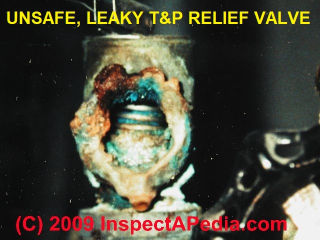 Relief Valve Leaks from Thermal Expansion
Relief Valve Leaks from Thermal Expansion
Hot water expansion TPR valve leak cause & cure
- POST a QUESTION or COMMENT about the causes & cures of leaks and discharges from force per unit area relief valves or TP valves
InspectAPedia tolerates no conflicts of involvement. We have no relationship with advertisers, products, or services discussed at this website.
Why the relief valve leaks: thermal expansion of hot water
This article explains hot water thermal expansion that can cause leaks, drips, or discharges from pressure level relief valves, temperature/pressure relief valves, or TP valves found on heating boilers, water heaters.
We explain how to detect and ready leaky relief valves on hot h2o heating systems.
Lookout out: a dripping or oft spilling T&P valve is dangerous because those very leaks can eventually cause the valve to clog and and so to fail to open when it should.
We likewise provide an ARTICLE INDEX for this topic, or you tin can attempt the page top or bottom SEARCH BOX as a quick way to find information you need.
Airtight Hot Water Systems & Thermal Expansion Bug - Why is the Water Heater Relief Valve Leaking?
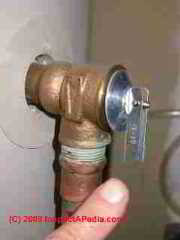 Watts and other manufacturers of TP valves warn of serious safety hazards acquired past dripping at the TP discharge line and point out that often the dripping is acquired past thermal expansion of hot water.
Watts and other manufacturers of TP valves warn of serious safety hazards acquired past dripping at the TP discharge line and point out that often the dripping is acquired past thermal expansion of hot water.
When water is heated in a closed plumbing system, it expands, causing an increment in pressure level. This increase in system pressure over that regulated by the pressure reducing valve is called thermal expansion pressure. The T&P valve is a safety device and is non intended for continuous performance to relieve thermal expansion.
Continuous dripping tin can cause the build up of mineral deposits on the valve and may render it useless. - Watts (2011)
Meet HOT WATER Force per unit area EXPANSION Charge per unit - for an explanation of merely how much pressure increase to await when heating water. In explaining why the relief valve on a water heater may be dripping, American Water Heater Co. [1] explains:
Periodic belch of the temperature and pressure level relief valve may be due to thermal expansion in a closed water supply system. The water utility supply meter may contain a check valve, backflow preventer or water pressure reducing valve. This volition create a airtight water system.
During the heating cycle of the water heater, the water expands causing force per unit area inside the h2o heater to increase. This may cause the temperature and pressure level relief valve to discharge pocket-size quantities of hot water. To forestall this from happening, there are two recommendations:
- Install a diaphragm-type expansion tank that is suitable for potable water on the cold h2o supply line. The expansion tank must have a minimum chapters of 1.5 U.Southward. gallons for every fifty gallons of stored water.
- Install a 125 PSI pressure level relief valve in the common cold water supply line. Make sure the belch of this valve is directed to an open drain and protected from freezing. [1]
Annotation: While a 125 psi pressure relief valve on cold h2o supply piping is fine to protect piping from rupturing, if edifice incoming water pressures are too high, rather than relying just on a relief valve (wasting h2o) we prefer to install a pressure reducing/command valve at the edifice inbound water supply piping. Limit incoming water pressure to lx psi at a typical one or two story residential home.
How to detect that a TPR valve is dripping due to thermal expansion
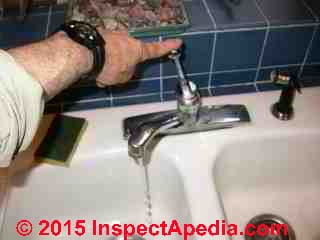 There are several reasons that a temperature/pressure relief valve or TPR valve might be dripping or leaking.
There are several reasons that a temperature/pressure relief valve or TPR valve might be dripping or leaking.
Meet RELIEF VALVE LEAK for a consummate discussion of leaky TP valves.
Watts (2011) suggests two methods for testing for thermal expansion of hot water as the crusade of a TP valve drip. The text below is adapted from that source.
- Open up a water faucet and see if the dripping stops: If the TPR valve is leaking due to thermal expansion of hot water, simply opening a water faucet or fixture anywhere in the plumbing organization volition immediately stop the baste.
That's because opening the hot water faucet reduces the arrangement pressure back to normal operating levels - we are no longer heating water in a "closed" piping and tank arrangement.
Why would opening either a hot or cold h2o faucet piece of work? Because when no water is running, the entire plumbing arrangement is "closed" - unless there is an expansion tank already installed on the hot water heating arrangement to accommodate thermal expansion, heating water in the water cylinder (water heater for Yanks) causes an increment in system pressure.
- Monitor actual water piping system force per unit area using an temporarily or permanently-installed pressure gauge:
Install a force per unit area guess on a convenient hose bib such as at the washing machine hook-up or if atmospheric condition permits, outdoors. Install & apply the force per unit area gauge to monitor organisation water force per unit area over at to the lowest degree a total 24-hr period. You don't have to slumber by it. If yous select a pressure approximate with a re-settable "telltale" needle, the gauge's re-settable indicator will indicate the highest pressure that has been reached by the water organization since the water pressure test gauge was installed.
Run into MEASURE Water Organization PRESSURE & PRESSURE MAXIMUM for tips on how to brand or purchase an inexpensive recording-type water pressure exam gauge for this purpose.
Solutions for Dripping TPR Valves due to thermal expansion of hot water are given
at HOT WATER EXPANSION TANKS where nosotros draw both hot h2o expansion tanks and hot water expansion relief valves designed to handle thermal h2o pressure level increases and thus to stop dripping TP valves.
Watch out: get advice from a licensed plumber and your local water supplier. Never remove or plug a leaky pressure/temperature relief valve on a water heater - doing and so risks dangerous or fifty-fifty fatal
BLEVE EXPLOSIONS.
See RELIEF VALVE LEAK DUE TO EXPANSION TANK where in a series of steps a homeowner figures out that a leaky TPR valve is due to the failure of the internal bladder of an expansion tank attached to the boiler.
Also see the FAQs below where nosotros discuss closed plumbing systems caused by bank check valves on the cold water line.
If the edifice water pressure level gauge reading is ever institute at eighty psi or college, you volition want to install a h2o pressure regulator at the bespeak where water supply enters the building.
If your building already has a h2o force per unit area gauge installed, it may be defective or information technology may be set too high. The articles listed simply below discuss how to adjust a h2o pressure regulator:
- Water Force per unit area REDUCER / REGULATOR
- WATER Force per unit area REDUCER / REGULATOR FAQs
- WATER PRESSURE VARIATION CAUSES
- WATER PRESSURE REGULATOR ADJUSTMENT
Cures for Water Heater Relief Valve Leaks due to Thermal Expansion: Expansion tanks to relieve loftier water pressure
An alternative to installing or changing a water pressure level regulator when building h2o pressure is occasionally eighty psi or higher is the installation of an expansion tank to temporarily blot that pressure increment.
Proper use of an expansion tank can assist avert unnecessary opening of the pressure/temperature relief valve on a hot h2o heating tank or a hot water heating boiler.
Reader Comment: why is a water heater expansion tank ever necessary?
2017/01/08 GaryC said:
Y'all become through alot of effort to explicate how heated h2o expands and the resulting increase in pressure. All that is well and adept for theory. In a domestic (North American) h2o supply organization, to the best of my knowlege there is nothing to preclude the expanding water/pressure level from the hot water heater from just bankroll up into the supply plumbing and hence the h2o pressure in the hot water heater would NEVER exceed the supply pressure. Or is in that location a required i fashion valve somewhere in the system I am not aware of say in the hot h2o heater?
This annotate was posted originally at RELIEF VALVE, Water HEATER
Reply:
Good question, Gary. Thanks.
Domestic water systems in well-nigh cities are required to have a backflow preventer or check valve on the organization. So when no h2o is beingness run the system is in effect closed.
My original interest and intent was to prove that the bodily expansion in volume from heating water is actually very small. Nevertheless, on some systems, the water heater can cause plenty of a pressure increase that some installations include a modest water heater expansion tank.
Even where a backflow preventer is not installed, the pressure/reducer valve at the municipal supply acts as a check valve.
And on a water organisation on a private well, the system pressure encounters a bank check valve at the water pump or a foot valve in the well.
Where expanding hot water pressure level is causing problem the mutual solution is the installation of a small expansion tank, normally on the hot water supply line above the water heater, though it could go almost anywhere so long every bit it'southward not isolated from the heater past a shutoff valve.
Amtrol'southward Therm-10-Trol expansion tank is sold specifically for this application. Here is what Amtrol says about that product:
Thermal expansion occurs equally domestic water is heated. Left unchecked, the resulting pressure increment can cause relief valve discharge and other potentially hazardous atmospheric condition. Therm-X-Trol® expansion tanks blot this expanded h2o, keeping h2o pressure at a safe level.
...
Water heater manufacturers and plumbing codes require the installation of an expansion control device if a backflow preventor, pressure reducing valve or check valve is installed in the domestic supply line.
Sentry out: a leaky relief valve on a water heater, heating banality, or any other airtight vessel is dangerous. Leaks ultimately can pb to relief valve clogging, failure, and worse, BLEVE EXPLOSIONS. First at RELIEF VALVE LEAKS we describe all of the causes of and cures for leaky relief valves or TP valves.
Standards & Referencs on Hot H2o Expansion Requirement for Expansion Tanks or Control Valves on Water Heater Systems
- ANSI BS 7074-1:1989, Awarding, choice and installation of expansion vessels and coincident equipment for sealed water systems. Code of do for domestic heating and hot water supply (British Standard) RHE/7[91.140.x]
- IAPMO IGC 128-2008, H2o heater supply shutoff valves with a thermal expansion control valves, at ansi.org. Extract:
This standard covers the test methods and performance requirements applicative for waterheater supply shutoff valve with a thermal expansion control valves for use on closed plumbing systems.
- SS-EN 1491:2000, Building valves - Expansion valves - Tests and requirements (Swedish Standard), at ansi.org. Excerpt:
This European Standard specifies, dimensions, materials and performance requirements (including methods of exam) for expansion valves, of nominal sizes from DN fifteen to DN twoscore, having working pressures i) from 0,1 MPa (50 bar) to 1,0 MPa (x bar).Expansion valves are intended for fitting to the common cold h2o supply of storage water heaters, having a maximum distribution temperature of 95 °C, for all energy sources.
Expansion valves do non command the temperature and lonely does not constitute the protection required for storage water heaters. Expansion valves limit pressure level, in the water heaters to what they are fitted, that is produced by thermal expansion of the water .NOTE : The apply of the device specified in this Standard does not override the demand to apply controls (due east.k. thermostats and cut-outs) which act directly on the power sources of water heaters.
- "THERM-X-TROL® Water Heater Expansion Tanks", [web page] Amtrol,1400 Division Road, West Warwick RI Usa 02983, Tel: 800-426-8765, Website: www.amtrol.com, retrieved 2017/01/08, original source: http://world wide web.amtrol.com/thermxtrol.html
- "THERMAL EXPANSION TANKS for Beverage WATER, Installation & Functioning Instructions" [PDF], Models ST-5 through ST-201V & Models T-5 through T-12, Amtrol, Op. Cit., retrieved 2017/01/08, original source: http://www.amtrol.com/media/documents/thermxtrol/9015087_06_16_Thermal_Expansion_Tank_IO_.pdf
Reader Comments & Q&A
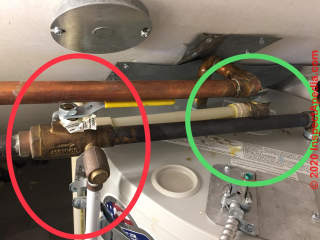 Karla
Karla
You lot've got it correct; the green-cirvcled valve is a temperature/force per unit area relief valve (that you say is not leaking)
and
the cherry-circled valve is a combination of common cold water inlet shut-off valve and a drain intended to provide relief against excessive pressure in the water heater due to thermal expansion - every bit discussed on this page.
Similar products manufactured by Watts are described at
B&Thousand - Bell & Gossett
Jomar
The valve could exist leaking from over-pressure, h2o hammer, or other causes listed above on this page.
Karla
You've got it right; the green-cirvcled valve is a temperature/force per unit area relief valve (that you lot say is not leaking)
and
the ruby-circled valve is a combination of common cold water inlet shut-off valve and a drain intended to provide relief against excessive force per unit area in the h2o heater due to thermal expansion - as discussed on this page.
Similar products manufactured past Watts are described at WATER HEATER THERMAL EXPANSION PRODUCTS - WATTS [PDF] https://inspectapedia.com/plumbing/Watts-Thermal-Expansion-Products.pdf
Here is a closer image of the P/T valve on the water heater. (it does wait somewhat corroded)
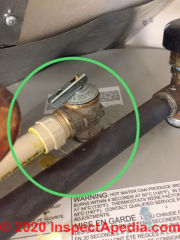
[Shown at the offset of this word ] is an image of the fix. The water is coming from the valve/tube circled in reddish.
Karla
Tin you employ the "add together image" push button to post a photo?
I want to be certain nosotros are not seeing h2o dripping out of an ordinary Pressure/Temperature relief valve as that can be dangerous.
My hot h2o tank has a Thermal Expansion Control Valve installed on the cold water intake line (rather than an expansion tank). In the by two-3 days, I take noticed that there is a small amount of water constantly draining out of this Valve/Tube.
The leakage is constant, even during/after a long hot shower, which presumably would bleed a lot of the hot water out of the tank and temporarily stop any thermal expansion/condensation. It is of import to annotation that the T&P valve on the h2o heater itself is fine, in that location is no leak or release of force per unit area/water happening in that location.
My gut instinct is that the Thermal Expansion Control Valve is but faulty and stuck open in some manner.
(Why else would information technology even so leak when the hot water tank is beingness tuckered and cold water is entering the tank?). Wondering if anyone has whatever thoughts on this? I'm pretty certain I should be calling in for a repair, but unsure how urgent. (Am I at take chances of a BLEVE explosion given the leak is abiding, fifty-fifty when the tank should not be up to temp/pressure and even the pipe betwixt the tank and the valve feels cold?).
Thanks!
Stephanie
A typical pressure/temperature relief valve used on a residential water heater volition run across these specifications:
Temperature Relief: 210°F (99°C)
Pressure level Relief Range: 75 to 150 psi (5.ii to 10.3 bar).
It is possible on SOME water heaters to set the temperature higher up 210°F (99°C) only in my experience that would be unusual - y'all'd take probably scalded everyone using the hot water system.
As I advised another reader below,
A adept place to offset is with the diagnostics at RELIEF VALVE LEAK CAUSES inspectapedia.com/plumbing/TP_Valve_Leaks.php
where you'll discover a list of mutual reasons that the valve might be leaking.
Lookout out: a leaky TPR valve is unsafe.
1. It is already telling u.s.a. that (usually) there is an unsafe condition such equally force per unit area too high (h2o tank tin blow up in a BLEVE explosion) or temperature as well high (someone can be scalded - burned)
2. If it's dripping just because the valve itself is old and defective the hazard is that calibration clogs the valve, it stops relieving, then you're missing a critical life-safety device.
If your h2o heater is set at very hot could that crusade the pressure relief valve to blow.
Wall
A good place to start is with the diagnostics at RELIEF VALVE LEAK CAUSES http://inspectapedia.com/plumbing/TP_Valve_Leaks.php#TP_Leak_Causes
the hot water heater has been shut downward about one year , I lit the polite then went back a few hours later when I noticed the pressure level relieve valve was spraying water out. so I close the gas off. not sure what's going on. ?
...
Continue reading at HOT WATER EXPANSION TANKS for a solution to thermal expansion leaks at relief valves on water heaters, or select a topic from the closely-related manufactures below, or see the consummate Article Index.
Or encounter these
Recommended Articles
- EXPANSION TANK WATERLOGGED, RELIEF VALVE LEAKS
- HOT WATER PRESSURE EXPANSION RATE - how much does water expand when you heat it?
- RELIEF VALVES - TP VALVES - topic domicile where we include additional relief valve information including for hydronic heating and steam heating boilers used for central heating.
- RELIEF VALVE LEAKS
- RELIEF VALVE LEAK CAUSES
- Prophylactic HAZARDS of LEAKY TPR VALVES
- THERMAL EXPANSION TPR VALVE LEAKS - separate article
- GAS SIDEARM Scroll SPECIAL Bug
- RELIEF VALVE LEAK DUE TO EXPANSION TANK
- HOT H2o PRESSURE EXPANSION Rate
- HOT WATER EXPANSION TANKS
- THERMAL EXPANSION of HOT H2o for an explanation of the amount by which h2o expands when heated
Suggested citation for this web page
THERMAL EXPANSION TPR VALVE LEAKS at AuditApedia.com - online encyclopedia of building & environmental inspection, testing, diagnosis, repair, & problem prevention advice.
Or see this
INDEX to RELATED ARTICLES: Article Alphabetize to T&P RELIEF VALVES
Or apply the SEARCH BOX found below to Ask a Question or Search InspectApedia
Or see
INDEX to RELATED Manufactures: Article Alphabetize to PLUMBING SYSTEMS
Or employ the SEARCH BOX found beneath to Ask a Question or Search InspectApedia
...
Ask a Question or Search InspectApedia
Try the search box just below, or if you prefer, post a question or annotate in the Comments box below and we will respond promptly.
Search the InspectApedia website
Notation: appearance of your Comment below may be delayed: if your comment contains an image, web link, or text that looks to the software equally if it might be a spider web link, your posting volition appear subsequently information technology has been approved past a moderator. Apologies for the delay.
Technical Reviewers & References
Click to Testify or Hide Citations & References
Publisher InspectApedia.com - Daniel Friedman
Source: https://inspectapedia.com/plumbing/Water-Thermal-Expansion-Leaks.php
0 Response to "what do i need to do when my pop off valve leaks"
إرسال تعليق